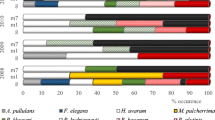Abstract
The yeast flora associated with the surface of grapes during ripening was studied with regard to different sectors of the grape skin and the position in the bunch by means of traditional as well as more vigorous preisolation and precounting treatments. The yeast number per square centimeter of skin increases with ripening and is highest in the area immediately surrounding the stem. The cluster sector closer to the peduncle seems to constitute a favorable substrate for yeasts, hosting a resident flora about 10 and 100 times higher than the central and lower parts of the bunch, respectively.Kloeckera apiculata was the normal resident species of grapes regardless of the sector or the ripening period, and constitutes the fermenting flora of mature grapes. The ecological implications of the results of this survey are discussed.
Similar content being viewed by others
References
Barnett JA, Delaney MA, Jones E, Magson B, Winch B (1972) The number of yeasts associated with wine grapes of Bordeaux. Arch Mikrobiol 23:52–55
Belin J -M (1972) Recherches sur la repartition des levures á la surface de la grappe de raisin. Vitis 11:135–145
Castelli T (1954) Les agents de la fermentation vinaire. Arch Mikrobiol 20:323–342
Davenport, RR (1974) Microecology of yeasts and yeast-like organisms associated with an English vineyard. Vitis 13:123–130
Federici F, Martini A (1980) Effetti di basse frequenze ultrasoniche sui lieviti. Ann Sclavo 22:286–288
Federici F (1981) Effects of ultrasonic treatment on yeast budding. J Gen Appl. Microbiol (Tokyo) 27:195–197
Hansen EC (1903) Neue Untersuchungen über den Kreislauf der Hefenarten in der Natur. Zentr Bakteriol 10:1–8
Ingram M, Lüthi H (1961) Microbiology of fruit juices. In: Fruit and vegetable juices processing technology. The AVI Publishing Co Inc, Westport, Conn
Kunkee RE, Maynard A, Amerine A (1970) Yeasts in wine-making. In: Rose AM, Harrison IS (eds): The Yeasts, vol III. Academic Press, London, pp. 5–71
Martini A, Federici F, Rosini G (1980) A new approach to the study of yeast ecology of natural substrates. Can J Microbiol 26:856–859
Parle JN, Di Menna ME (1966) The source of yeast in New Zealand wines. J. Agr Res 9:98–107
Pasteur L Mémoiressur la fermentation alcoolique. CR Acad Scs (Paris), XLV:1032–1036 (1857); XLVIII: 1149–1152 (1859); L: 1083–1084 (1860)
Phaff HJ, Miller MW, Mrak EM (1978) The life of yeasts, 2nd edn. Harvard University Press, Cambridge, Mass
Riberau-Gayon J, Peynaud E (1960) Traite d'oenologie. Tome premier. Librairie Polytechnique Ch. Béranger, Paris, pp 204–225
Sergent E, Rougebief H (1960) In: Ribérau-Gayon J, Peynaud E Traité d'oenologie. Tome prémier. Librairie Polytechnique Ch. Bérganger, Paris, p 205
Van der Walt J -P (1970) Criteria and methods used in classification. In: Lodder J (ed) The yeasts. A taxonomic study. North-Holland Publishing Co, Amsterdam London, pp 34–113
Author information
Authors and Affiliations
Rights and permissions
About this article
Cite this article
Rosini, G., Federici, F. & Martini, A. Yeast flora of grape berries during ripening. Microb Ecol 8, 83–89 (1982). https://doi.org/10.1007/BF02011464
Issue Date:
DOI: https://doi.org/10.1007/BF02011464




